The way we perceive and treat each other in the workplace has undergone a profound transformation over the years. From a time when job opportunities were dictated by factors beyond one’s skills to today’s push for inclusivity and fairness, the evolution of workplace equality reflects our societal progress.
Let’s explore how fairness at work has evolved over time, incorporating insights from industry leaders who have played a crucial role in shaping workplace equality.

Jobs and Unfair Rules
In the past, there were strict rules about who could do specific jobs. It didn’t matter if you were really good at something, what mattered was who you were. Some people got more chances just because of where they were born or how they looked. This wasn’t fair, and people knew it. Luckily, things started to change.

Nisha Krishnan, Founder and CEO of Channeliam.com, sheds light on this, stating, “Women have made progress in traditionally male-dominated fields and in leadership positions in many organisations.” This highlights the systemic barriers that women and marginalised groups have had to navigate in their quest for workplace equality.
Factories and the Call for Fairness
As factories and big machines came into play, things started shifting. However, it wasn’t all sunshine and rainbows. People had to work really hard, and sometimes the conditions were tough. But, this led workers to unite and say, “We deserve better!” This marked the beginning of people working together to make things fairer at work.
Nisha further notes, “Efforts have been made to address gender pay gaps by conducting pay equity analysis and implementing policies.” This underscores the importance of proactive measures in rectifying disparities and fostering a more equitable work environment.
Breaking Barriers in Jobs
Not too long ago, women stepped up and said, “We can do any job just as well as men!” They fought for the right to work in any job they liked. Laws were made to stop bosses from treating women differently. This was a significant step in making sure everyone had a fair shot at any job, regardless of gender.

Neelam Singh, Head of Information and Fact-Checking at The Healthy Indian Project, reflects on her experience, stating, “The struggle was to find a place for women in the corporate environment.” Singh’s observation underscores the persistent challenges that women have faced in traditionally male-dominated sectors.
Around the same time, people from different races fought for fairness too. New laws stated that you couldn’t be treated differently because of your skin colour. This was another big leap towards fairness at work, ensuring that everyone had an equal opportunity.
Embracing Diversity and Inclusion
Today, we’re still working on making work fair for everyone. We want everyone to have a chance, no matter where they’re from or what they look like. We’re trying to get rid of things like judging people without really knowing them and making sure everyone feels good about their work. It’s all about embracing diversity and inclusion.
Neelam emphasises the importance of continuous dialogue and representation, stating, “There is no greater initiative than continuous discussion, debate, and representation.”
Why it Matters
The journey of equality is ongoing, and it’s something we all need to work on together. It’s not just about rules, it’s about treating everyone with kindness and giving everyone a fair shot. When everyone gets a fair chance, we all get to see how good people really are at what they do. And when work is fair, everyone feels good about what they’re doing, making the workplace a happier and better place.

Be the Best You: When everyone gets a fair chance, we all get to see how good people really are at what they do.
Feel Happy at Work: When work is fair, everyone feels good about what they’re doing, and that makes the workplace a happier and better place.
Be a Good Team: When everyone is treated the same, we can all work together better and get more things done.
Do the Right Thing: Treating everyone fairly is not just a good idea, it’s the right thing to do. It makes work better for everyone.


The road to workplace equality is long and winding, but with each step forward, we inch closer to a more just and inclusive society. Let us heed the insights of industry leaders and champion a culture of fairness, respect, and inclusivity in all aspects of our professional lives. For, in embracing diversity lies the true essence of progress and prosperity.
